80 anniversary of the first transpolar flight and the 120 anniversary of the birth of A. Belyakov. Dedicated
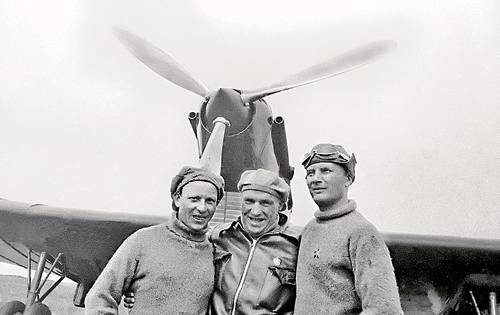
In 2017, there will be several significant events related to Lieutenant-General Belyakov: firstly, of course, this is 120 years since its birth, and secondly, the 80 anniversary of the first non-stop polar flight of the USSR - the USA. This flight expanded the boundaries of the possible, giving a great impetus to the development of the aircraft industry and, of course, allowed to use the shortest path between the USSR and the USA, bringing together two superpowers of its time. And who knows what other horizons the restless daredevil’s plane, led by his navigator Alexander Vasilyevich Belyakov, would have disappeared, if it had not been for the death of legendary pilot V.P. Chkalov in 1938 and the beginning of World War II in the near future. But they dreamed of flying around the Earth and across the South Pole. But, without breaking under the weight of those events, AV Belyakov continued his life flight, one of the results of which was the military department of the Moscow Institute of Physics and Technology in the form in which we know it.
15 July 1929 of the year comes the decree of the Central Committee of the CPSU (b) "On the state of the defense of the USSR", according to which the development of red aviation should be given a new qualitative impetus so that the planes built in the USSR would not yield to the best bourgeois models. They called for this through the creation and development of their own scientific design bureaus. The development of aviation in the USSR, and before that especially supported at the highest level, is gaining even greater momentum. By 1934, the purchase of foreign aircraft completely ceases, and the characteristics of domestic aircraft, as they are said, are becoming competitive. At this time, the idea of an aircraft capable of flying over distances over 10.000 km was born in the USSR. To perform this task, the design office of A.N. Tupolev developed the ANT-25 aircraft. Tests of the new aircraft showed that the designers successfully coped with the goal. In 1934, test pilot MM Gromov together with his crew makes a non-stop 75 hour flight on ANT-25, during which they traveled more than 12 thousands of kilometers.
Thus, at the beginning of the 1935 of the year, the USSR had an aircraft capable of making super-long flights and a desire to declare itself as the leading aviation industry. The first attempt to demonstrate the capabilities of Soviet aircraft manufacturing at the world level was decided by the hero of the Soviet Union, Sigismund Aleksandrovich Levanevsky. At a meeting in the Kremlin, Levanevsky asked Stalin for permission to organize the world's first transpolar Moscow-San Francisco flight.
This flight would have not only great political, but also practical significance. If you take the Earth map in hand and make some simple mathematical calculations, you can immediately determine that the shortest path between Moscow and San Francisco lies through the North Pole and is only 9605 km. However, at that time, the main route was the route that runs through Europe and the Atlantic Ocean, which was much longer - 14 thousands of kilometers. The path through the Pacific Ocean was at all longer than all the previous ones - 18 thousands of kilometers.
Alexander Vasilyevich Belyakov taught air navigation at the Zhukovsky Academy in 1935. In the same year, S.A. Levanevsky studied at this academy to improve his knowledge. There they met. Levanevsky highly appreciated the abilities of Alexander Belyakov and suggested that he become a reserve navigator in this risky flight. Belyakov recommended to include in the team a first-year student of the engineering faculty of the Academy GF Baidukov, with whom he had recently flown to France. Levanevsky accepted his recommendations and as a result, the crew of the ANT-25 aircraft, which was to try to make the first transpolar flight, consisted of: the aircraft commander, S.A. Levanevsky; second pilot - GF Baidukova; ship navigator - V.I. Levchenko; reserve co-pilot - V.M. Levchenko; reserve navigator A.V. Belyakov. The crew under the command of Levanevsky was faced with a very large program of ground and flight training, which had to be completed in 3 of the month. The plane itself needed to be seriously refined, so that it could carry out a flight across the entire North Pole. Belyakov approached the upcoming mission with all his pedantry and responsibility. During the preparation, he personally trained the entire air navigation team. Since no one had any practical experience in navigating the North Pole, and the task was extremely difficult, Belyakov taught them all known types of air navigation: magnetic compass, solar compass, astronomical and radio navigation, and also prepared for the subsequent delivery of the state test . The merit of Alexander Vasilyevich Belyakova was also in equipping the aircraft with the latest navigation devices. They had to ensure the possibility of a successful flight in any meteorological and magnetic conditions; without them, this flight would be absolutely unthinkable. Belyakov personally developed and created a solar course indicator, made tables of the position of somner lines (method of determining the location of a ship or aircraft) of the Sun and the Moon depending on time, installed the world's first gyromagnetic compasses on ANT-25, developed exchange and meteorological codes for telegraph communication and carried out many other important preparatory activities. At the beginning of August 1935, the crew of the ANT-25 aircraft, commanded by Levanevsky, takes off from the Schelkovo airfield and heads for the North Pole.
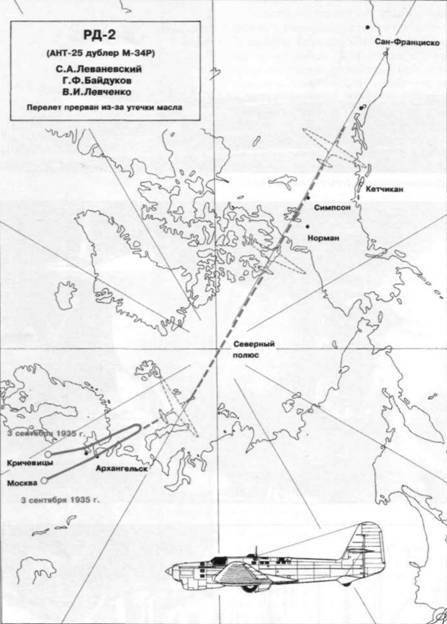
It was a beautiful weather, which gave the pilots confidence in the success of the mission. However, a few hours after the start of the mission, Levanevsky discovered a jet of oil flowing along the left wing of the aircraft and flowing inwards. The crew reported to the headquarters, from where it was ordered to stop the flight and return. After landing between Moscow and Leningrad at the airfield in Krechevitsy, another misfortune occurred - the plane caught fire. Fortunately, that day there were no casualties, and none of the crew members was injured. Thus, the first attempt to establish the shortest path between the USSR and the USA ended rather ingloriously. This failure, which almost became a tragedy, and the death in the same year of the famous American pilot Willy Post in Alaska gave rise to the opinion that the North Pole was inaccessible, and you shouldn’t even try on a single-engine plane that was ANT-25. However, Belyakov and Baidukov did not share this opinion. They often discussed issues relating to the ANT-25 and the further solution of the task, the only unsolved issue in these conversations was the pilot of the aircraft. As a result, it was decided that they should be Chkalov.
In the late autumn of 1935, Grigory Filippovich Baidukov drove home to Valery Pavlovich Chkalov and tried to persuade him to take part in the flight so important for the country. After 2 weeks, Chkalov was invited to inspect the ANT-25 and try it in flight. At first, Chkalov carefully studied the structure of the aircraft with a record for that time wing elongation and flight schedules over an extra long distance. After which he was allowed to make a training flight, which Chkalov was very pleased with. In the spring of 1936 the crew was completely ready to conquer the impregnable North Pole, because Chkalov and Baidukov turned to Sergo Ordzhonikidze with a request to allow another flight. However, Ordzhonikidze could not assume such responsibility, therefore he promised to organize a meeting with Stalin to discuss such an important issue. The case soon presented itself, in early June 1936 the Central Committee of the All-Union Communist Party of Bolsheviks held a meeting in the Kremlin, where Chkalov and Baidukov were invited as test pilots. There Ordzhonikidze introduced them to Stalin. Comrade Stalin doubted the need for such a flight, so he offered the pilots a replacement - the route Moscow - Petropavlovsk-on-Kamchatka. Stalin's fears were understandable: the reputation of the USSR and its air fleet a serious blow could have been dealt, therefore even the possibility of a repeated mistake could not be allowed. In addition to the entire aircraft, a revision was clearly needed, and such a long flight through the territory of the USSR would reveal the flaws of the ANT-25 design, and in case of failure the story would not go outside the country.
By decree of Sergo Ordzhonikidze, the Stalin Route was to be performed by the crew of ANT-25, consisting of commander Valery Chkalov, co-pilot Georgy Baidukov and navigator Alexander Belyakov.
After a month and a half of intensive training and preparation, having completed the last test flight, the team, booting into the ANT-25 and taking on board the engineer with the radio operator, rose into the air. During the cleaning of the chassis, the crew heard a crash from below. As it turned out, one stand was not completely removed. Belyakov radioed the headquarters about the damage to the aircraft, asking all aircraft close to ANT-25 not to fly in so as not to be distracted by maneuvering; all the attention of the crew should have been focused on solving the problem.
To help deal with the damage, George Baidukov drew and handed over to Chkalov the scheme of the chassis, then replaced it, sitting down on the pilot's seat. Chkalov and the engineer Stoman dismantled the upper part of the pilot’s seat and saw seriously damaged lift and release chassis cables. On board, accidentally, there was a parachute, which Valery Chkalov tore and attached with straps to the chassis release cable. After that, he attempted to free the chassis, he began to pull, but, despite all the strength of Chkalov, it did not bring any special results. All that was possible was to move the left rack just a few centimeters. The chassis of ANT-25 should have been released forward, against the air flow, because to help the team a little bit, Baidukov slowed down the speed to the minimum. Chkalov was joined by Stoman and Belyakov, but the chassis no longer moved off. Then the former sailor, radio operator Kovalevsky joined the common efforts, his efforts also did not have the desired result. Finally, Baidukov has an idea - to jerk the cable in jerks, and fix every gained centimeter with a sufficiently strong and sharp object. Fortunately, the engineer had a metal crowbar with him, which it was decided to use for this task. Thus, a centimeter per centimeter, the crew conquered the landing gear in this fight for the aircraft, and here is one landing gear on the loose. However, after another 4 hours of continuous struggle, it became clear that the second chassis was stuck tight, and the plane would have to land only one. At that moment everything began to depend on Chkalov’s composure and skill. He had the hardest landing of the aircraft on the left rack. And now the left wheel smoothly touches the ground, the landing has begun. Chkalov gradually turns the steering wheel to the left, not allowing the aircraft to lie on the right wing. The speed of the plane falls, Chkalov turns the steering wheel to the left and abruptly moves the foot pedal there, but the plane does not listen anymore, another second, and he lies down on the right wing and freezes, the end of the landing.
Thanks to the masterly landing of Valery Chkalov, the aircraft was left virtually unscathed, and therefore it was only after 9 days that it was ready for a new flight. The second attempt to overcome the “Stalin route”, which separated Chkalov’s team from challenging the North Pole, did not take long to wait and was more than successful: in 56 hours 20 flight minutes in polar conditions without landing, the crew traveled 9374 kilometers, landing on Udd Island is now known to everyone as Chkalov Island.
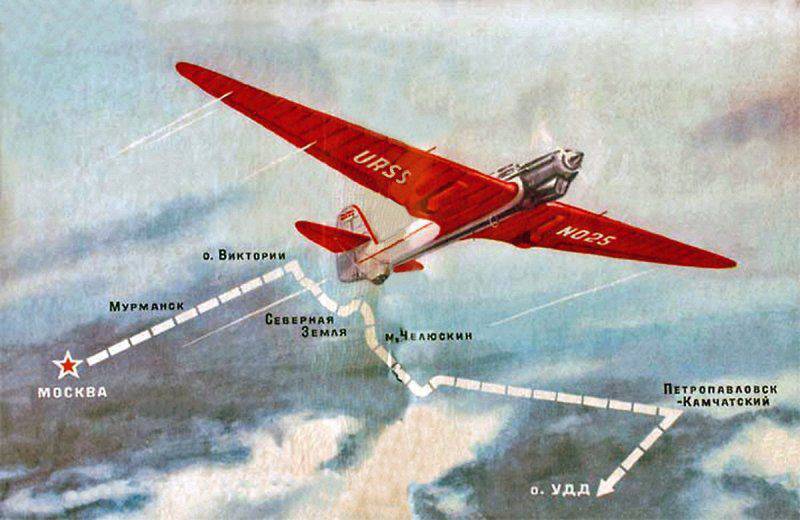
For this flight, the crew members of ANT-25, V.P.Chkalov, G.F. Baidukov, and A.V. Belyakov, were awarded the title Hero of the Soviet Union. An order of this was signed on 24 July 1936 of the year.
This flight revealed many flaws in the design of the ANT-25 aircraft and allowed the crew and engineers to carry out thorough preparations for the most important flight of the crew under the command of Chkalov. 25 May 1937, a team of brave pilots is called by phone to a meeting in the Kremlin. Belyakov was on the flight that day, and therefore only Chkalov and Baidukov went there. At this meeting, the troika received permission to fly, thanks to which they all made history. June 1 ANT-25 together with the team changes the place of deployment from the Central to Schelkovsky airfield, the training officially began. The crew devotes all its time to testing the aircraft's equipment, training flights, calculating every little thing on which the success of the whole event and the selection of everything necessary for such a daring flight could depend. The brigade of TsAGI engineers carried out their continuous watch at the car, making many improvements to the aircraft design, taking into account the shortcomings revealed by the Chkalov crew during the flight to the island Udd. Valery Chkalov spent a lot of time among the people involved in the preparation of the aircraft; in this difficult flight, everything depended not only on the professionalism and self-control of the crew. Much depended on the high-quality work of hundreds of people involved in the preparation of the aircraft, weather, equipment and much more. Everything had its meaning and required careful attention.
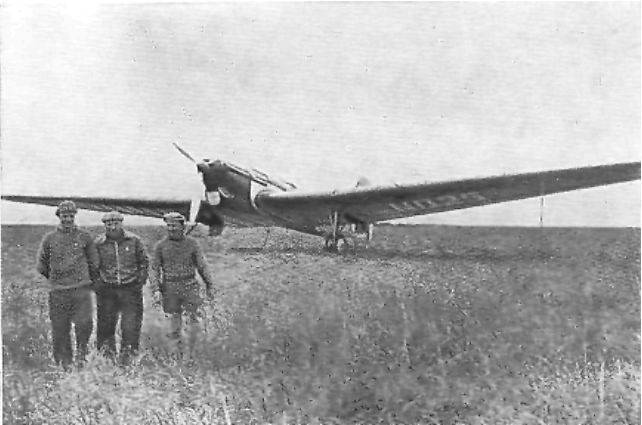
Baidukov and Chkalov regularly made training flights in order to learn how to observe speed and altitude indicators, and get used to the behavior of an overloaded vehicle; the aircraft will weigh more than 11 tons in this flight, and the landing gear is designed for seven and a half tons. At this time, Belyakov had many other duties. In particular, according to the results of training flights, he calculated the altitude and speed parameters in order to optimize fuel consumption. The most difficult task in this flight for the crew will be to determine its location. Belyakov planned to orient himself by the height of the sun, because to facilitate the calculation of the location he ordered astronomical institute special tables that speed up the processing of the heights of celestial bodies. These tables, in consequence, greatly facilitated astronomical orientation around the pole. Belyakov paid no less attention to the preparation of magnetic compasses and radio stations.
Belyakov also contacted the polar squadron, from which he received a detailed report on the orientation near the pole: which types of compasses behave, their deviations, which radio stations are available. From them, Belyakov received confirmation that astronomy would be the best way of orientation. Everything related to Belyakov, as a navigator in this flight, he wrote down in his famous notebooks. He studied the American and Canadian maps, where the coordinates of radio stations, civil airlines, as well as the call signs and frequency characteristics of all who could communicate with them were marked. All this was extremely important to know, as the radio compass installed for this flight on an airplane made it possible to determine the location of the aircraft by communicating with any two radio stations. However, a prerequisite for this was the knowledge of the coordinates of the stations. One of the important points of preparation was the flight schedule, who and when sits at the controls of the aircraft. Over the past year, Alexander Belyakov received a pilot specialty. This gave hope that, if necessary, Baidukov and Chkalov had someone to replace at the helm. June 16 after all the preparations and parting words, the crew receives a decision from Stalin to take off on June 18.
On the morning of June 18, the flight engineer gives the command “To launch”. Valery Chkalov masterfully takes off the aircraft loaded above the permitted parameters. Alexander Belyakov makes an entry in the logbook: “Take off - 1 hour 04 minutes GMT GMT 18 June 1937 of the year”. Baidukov instantly removes the chassis. The plane turns around and takes a course 0 °. In 5 hours 10 minutes GMT, Belyakov transmits the first radiogram: “I am Lekshm-lake. 1370 height meters. Everything is good. Belyakov. About 6 hours 30 minutes Belyakov decides, while they are still above land and visibility is good, to determine the drift angles, the speed and direction of the wind. He pulls out the reamer and notices that oil is flowing through it, which Baidukov immediately informs, which by then already had time to notice it. The crew shows calm and prudence, does not panic and soon it turns out that the oil meter is broken, but because they served the surplus in the supply tank, which flowed out. Pump out a little oil, the flow decreases, the flight can continue. In the 9 watch there is another shift: Chkalov is sent to rest, Baidukov takes the place of the pilot. Meanwhile, the outdoor temperature dropped to -4 °, which greatly increased the likelihood of icing, because Baidukov tries to escape from the cloud trap, but eventually the clouds catch the plane, and in 9 hours 36 minutes, blind flight begins. After a while, the icing begins, the plane begins to shake. Baidukov demands that Chkalov launch the defroster. In 10 hours 10 minutes Belyakov radiates: “Everything is fine. Blind flight. I am: latitude 69 ° 10 ', longitude 38 ° 00', height 2600. Ahead of the gaps, Belyakov. Then he recalls that after nine hours of flight it is necessary to switch to another wave. However, it turns out that the antenna is all covered with oil and iced up. Belyakov is worried that this will interfere with the operation of the radio, but verification shows that everything is in order, the flight can be continued without problems. In 11 hours, the clouds part a little, the Barents Sea and the ship become visible. Belyakov radiates about this and after a while goes to bed, Baidukov and Chkalov’s duty comes. After this, the cloudiness thickens again and the real depletion struggle begins with the harsh nature of the north pole. The crew of the ANT-25 meets the cyclone predicted by it. The next 9 watch crew members will regularly replace each other on the watch, and make large circles, just to not fall into the clouds where the plane can ic up.
In addition to the weather, problems were brought by high-altitude conditions: when flying at a height of more than 3000 meters, the crew felt oxygen starvation, and the temperature in the cabin was consistently below zero. In 20 hours 20 minutes through the clouds finally seemed the island. The crew reached the Franz Josef Land. At 22, GMT, visibility is getting better, the plane is at an altitude of 4 km, the temperature has dropped to -25. As the pole approached, the navigation became harder and harder, the arrows of the compasses rotated like mad, the navigator drove the plane through the shadow cast by some kind of “pin”, which actually was a solar course indicator. 19 June 1937, about 4 hours 15 minutes the plane flies near the pole. The navigator checks the somner line, which shows that they are already at the pole. Now Belyakov is faced with a crucial task - to change the direction of the course pointer. Prior to that, he was pointing to the North, now he must point to the South along the 123-meridian of western longitude. And Alexander Belyakov is doing this difficult work. Now we can definitely assume that they overcame the pole, but they are still far from the final goal, and the weather conditions are still severe, so the crew cannot afford to rest after the pole. At 9 hours GMT, the crew is trying to communicate with the American station in Alaska, however, despite all the efforts of the navigator, nothing happens, there is no answer. At about 10 in the morning, the plane encounters mountains of clouds, to bypass which, rises to a height above 5000 m. At this altitude, not only the crew, but also the plane feels bad, it now and then does not obey the steering wheel and fails. In 16 hours 15 minutes the crew went to the coast of Canada. Under them lay Cape Pierce Point. So, the main task is completed and the crew has the right to now land on the first available airfield, but the main destination is the United States, therefore, after consulting with Chkalov Baidukov, the flight continues. They have already traveled 6200 kilometers in a straight line, and they still have enough fuel. But even on the last leg of the journey, the flight conditions do not get better. The crew is exhausted, cloudiness, oxygen reserves are quickly depleted. Plus, if the crew wants to fly to San Francisco, then according to the calculations they have to slow down the engine speed, after which it becomes extremely cold in the cabin. Under such conditions, sleep does not bring proper rest, and it is almost impossible to force yourself to eat. On top of that, it turns out that the gas tank meter is broken and was showing the wrong value. And the main tank sensor shows that there is less than 60 kg of fuel left, the crew decides to urgently land at a military airfield in Vancouver. The goal, one can say, has been achieved, the non-stop trans-arctic flight of the USSR - the USA is almost complete. 20 June 1937 of the year at 16.20 GMT, on a rainy day ANT-25 makes a landing, completing its main flight in history, during which the crew traveled 63 thousands of 16 km in 11 hours of 430 hours.
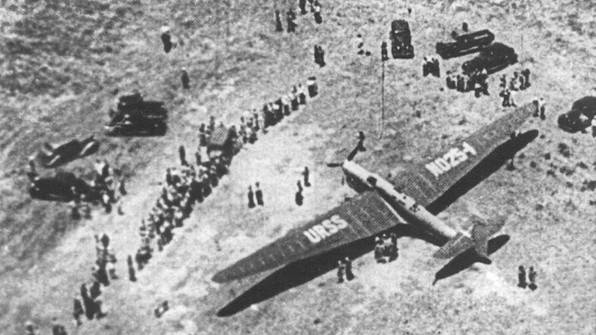
Heroes met at the highest level. At the aerodrome, the crew was met by General Marshall, the corps and aviation unit commander. Attempts to interview the crew for detailed interviews and autographs were terminated by Marshall. However, the public did not calm down and asked questions:
- Mr. Chkalov, tell me, whose engine do you have: English, American or German?
Valery immediately “uncoupled” the motor that had not cooled down after 63 hours of continuous operation, saying:
- Take a look, friends, at the emblem of our aviation plant, and you will see that everything here is ours, Russian, Soviet, and his name is AM-34Р.
In Vancouver itself, in honor of the Soviet pilots, they arranged a salute. After all, Marshall invited the guests to his mansion, where they could relax, pick up clothes and prepare to be sent to Portland, San Francisco, Chicago and Washington to meet with US President F. Roosevelt. It was one of the warmest receptions in the history of bilateral relations. After the crew, Chkalov was so eagerly greeted only Gagarin. So ended the most important flight in the history of aviation, which allowed to establish the shortest path between the United States and the USSR. The value and assessment of the studied route is high today.
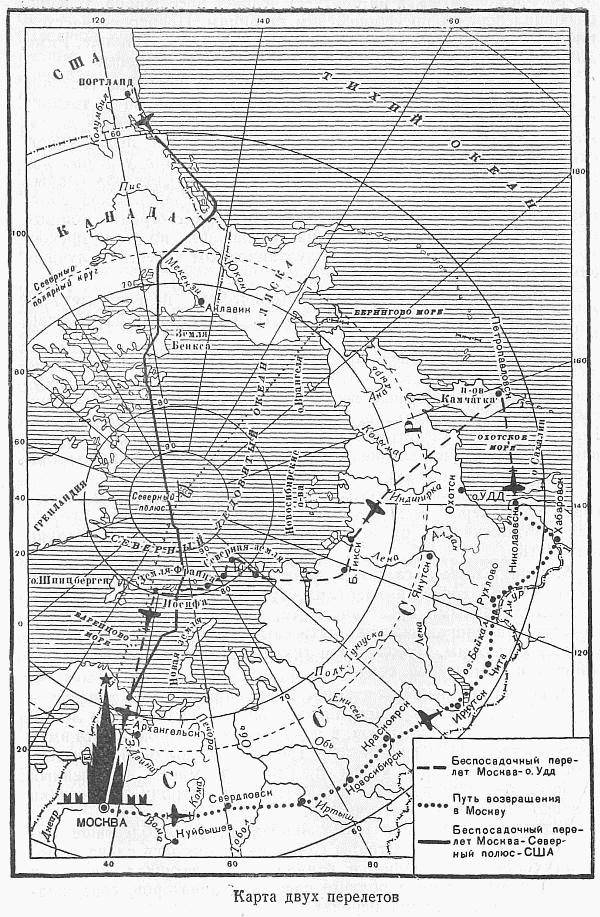
After such a triumphant event as the first non-stop transpolar flight, in the life of Alexander Vasilyevich Belyakov a series of sad events followed. This is the death of a close friend and illustrious pilot Valery Chkalov and the abolition of all further planned flights, which they and Chkalov dreamed of so much, because of the start of World War II. But Belyakov was not broken by life circumstances, steadfastly enduring the whims of fate, he continued his flight.
The last period of the life and work activity of A.V. Belyakov, starting from 25 on January 1961 and until his death, which followed 28 on November 1982, was associated with the Moscow Institute of Physics and Technology. The appearance of Professor A.V. Belyakov at the institute, which was established on the basis of the Physics and Technology Faculty of Moscow State University in the city of Dolgoprudny, Moscow Region in September 1951 to train scientific personnel in the newest areas of science and technology, cannot be considered accidental. Later, Alexander Vasilyevich recalled, despite the fact that he already had an invitation from the Moscow Engineering and Economic Institute to work as head of the department of aviation transport, after weighing all the circumstances, he agreed with the proposal to work at MIPT in 1961. The legendary navigator was always interested in the exact sciences, the innovations of technology, so the choice was not accidental.
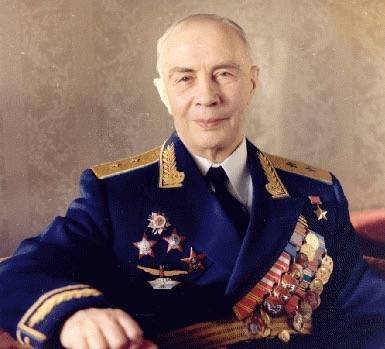
AV Belyakov’s stay in the post of vice-rector of the institute for educational and scientific work turned out to be short-lived. He liked more, his temper and age at that period, although he worked in a small but military team, which, by the way, then experienced great difficulties in its development and the search for directions for its further development. In addition, there was a thirst for teaching activity and the possibility of using the 15-year-old experience in practice to lead the navigator faculty of the Red Banner Air Force Academy. Since September 1, 1961, Professor A.V. Belyakov transferred to the post of head of the military department of MIPT, which until 4 November, 1960 was headed by the well-known former pilot-navigator Hero of the Soviet Union, Doctor of Geographical Sciences, professor, aviation general Lieutenant Spirin Ivan Timofeevich. He headed the military department from 1 July 1957, essentially was at the origins of its creation and made a great contribution to the organization of the educational process on the profiles of military training of students for the Air Force.
In a rather difficult situation, the retired aviation general-lieutenant A.V. Belyakov accepted the military department of MIPT, which he headed until March 1969, and in which he subsequently worked honestly for a total of about 22's. Before 1960, military training of students at MIPT was carried out, but essentially did not have certain profiles. The curriculum in its content did not quite meet the requirements for graduates of the institute, many planning documents were missing, including the department’s work plans and the personal work plans of the teachers. There was practically no educational material base, camp camps for students were not held. The military department was located in the left wing of the auditorium building of the institute and had only two training classrooms: Air Force tactics and air navigation and bombing. The total area of 7 premises occupied by the military department was only about 108 square meters.
Meanwhile, in our country and abroad continued the rapid development of jet technology, which began immediately after the end of the Second World War. The Air Force received new supersonic jet aircraft, in whose designs the latest advances in aerodynamics, radio engineering, electronics, materials science and other sciences were used. Alexander Vasilyevich understood that it took time and great efforts to create normal working conditions and form a workable team of like-minded people with good professional training. The question was not only about some improvement of the educational process and the material and technical base at the department, but also about the further directions of training reserve officers for the Armed Forces of the USSR from among the students of MIPT. As practice has shown, he almost always made the right conclusions and in any situation made the right decisions. An example of this could be the very flight in which Belyakov worked perfectly.
With the arrival of Alexander Vasilyevich, much has changed in the military department. And most importantly, people felt the closeness of changes, saw the prospects for further development and the opened possibilities of using their own forces and abilities in the matter of training and educating the younger generation. When talking with candidates for the appointment, Alexander Vasilyevich always made notes in his notebook and was friendly to the interlocutor, he always breathed calm, almost magnetic power. After the conversation, he usually asked the visitor in writing to state the reasons for his transfer to the military department, basic autobiographical data, information about military service, scientific training, family and housing conditions. Only after careful analysis, thorough reflection and coordination of all issues in the rector’s office of the institute did he make the final decision. His opinion was always considered the Deputy Commander for Higher Education Institutions and employees of military personnel bodies. Alexander V. with great respect for his colleagues and subordinates. Always, in any setting, he was simple and attentive, communicating with him was a real pleasure. He never portrayed himself as a hero, did not boast of his past achievements, did not indulge others around with stories from his truly heroic biography. The burden of fame, great popularity, wide popularity in our country and abroad have not spoiled this humblest person. Referring to the people with whom he had to work and communicate, Alexander Vasilyevich said: “I love sincere people who openly express their thoughts, impersonal and non-dual. I love people who are decisive, courageous, ready to give all their strength for the good of the Motherland. ” During Belyakov's work at MIPT, the staff structure of the military department was improved and acquired specific forms, any classes with students now received new coloring, were conducted more purposefully, the methodological and scientific level of teaching general military and special disciplines was constantly increased, military and military-patriotic education students. At the request of A.V. Belyakov, methodological assistance to the department was provided by teachers of military academies on related training profiles. There was intense work on the creation of new laboratory facilities, the equipment of classrooms and auditoriums, the writing of lecture notes and textbooks, and the improvement of the entire educational process. In many respects the military department was among the best departments of the institute. At a high organizational level, training sessions were held for students in the army. For good performance in educational and scientific work on the results of the 1964 / 65 school year, Lieutenant-General Aviation AV Belyakov. and thanks to the order of the Commander-in-Chief, gratitude was announced to several teachers of the military department. This was the first official recognition of the achievements of the military department, for which in subsequent years there were multiple rewards for personnel for success in training engineering personnel for the Armed Forces of the USSR. The great merit of Alexander Vasilyevich should be considered to be the creation of a businesslike and relaxed atmosphere at the department during this period, and a kind attitude of leadership towards young teachers. He did not make discounts for himself, he worked like everyone else. In dealing with minor and non-principled official issues, he completely trusted his deputies and heads of cycles. In his work, he loved concreteness and accuracy, tried to instill these qualities in his subordinates.
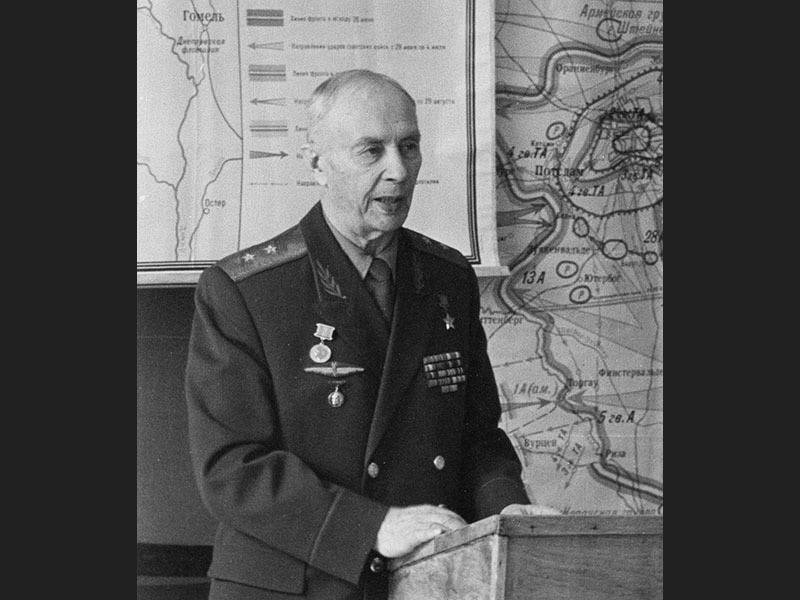
Professor Belyakov often spoke to students with memories of the history of Soviet aviation and navigation, the first ultra-long non-stop flights on domestic aircraft to the Far East, to various countries in Western Europe, to the island Udd and across the North Pole to America. In his stories, he spoke very little about himself, but sincerely spoke of the legendary pilot of that time, V.P. Chkalov, and the fearless pilot GFBaidukov, with whom he had to fly as a navigator, share all the joys and hardships dangerous work. His speeches aroused keen interest among students, graduate students, staff and faculty of the institute, gathered a wide audience, and in their focus were always turned to young people. In 1977, A.V. Belyakov, addressing the hall from the podium of the solemn assembly, said: “It is difficult to convey in words my feelings. I am happy that there are so many young people in this house. What to wish you, young friends? Be guided in your life by the principles of my illustrious friend Valery Pavlovich Chkalov - this extremely hardworking and fearless person. ”
The merits of Alexander Vasilyevich are not only historical non-stop flights in the crew of V.P. Chkalov, whose courage and courage we do not cease to admire. A.V. Belyakov is one of the founders of the national navigational school of air navigation, the author of a number of scientific works and literary works. He educated a whole galaxy of his students and followers in the navigator faculty of the Air Force Academy. Yu.A. Gagarin, and in recent years, all the wealth of his knowledge and the heat of the soul skillfully passed on to students of MIPT. In all the matters that were entrusted to him, he showed high responsibility, hard work, great organizational skills, intransigence to shortcomings, disinterested attitude to business, modesty and a sense of duty to his comrades. He deservedly enjoyed great prestige, universal recognition and respect.
Record flight - the most difficult test for pilots, and for the navigator, served as a huge impetus to the development of aviation and air navigation. The behavior of anti-icing, fuel systems, oxygen supply systems under extreme conditions was studied. The working conditions of the pilots reached a new level, the most courageous flights became possible. A real breakthrough of design skills was made, which served in the future as the basis for the creation of the highest-class flying machines. Based on the experience of the Chkalov crew, a month later our pilots made a similar flight, but already to San Francisco. The knowledge and experience of Soviet designers and scientists are currently used by the armed forces of the Russian Federation in the conditions of the Far North. In addition to design experience, this flight gave information about the meteorological situation at the North Pole, the behavior of the magnetic field in the Arctic. Radar and direction finders were improved. Another important consequence was the rapprochement of the Soviet people with the American. Now we are not so far from each other, the bridge with another continent is built by the shortest path, our countries are open for each other. The enthusiasm with which our pilots were greeted at that end of the route can only be compared with the commemoration of Yuri Gagarin, the first cosmonaut on Earth. In 1975, in honor of this event, a monument was opened in Vancouver. The ideas of peace, friendship of peoples and proximity to each other brought the legendary flight. In the 1976 year, despite the rather cold relations between our countries, US President D.Ford invited Belyakov, Baydukov and Valery Chkalov’s son I.V. Chkalov in honor of the anniversary of the flight, where they were awarded commemorative awards. Undoubtedly, Alexander Vasilyevich Belyakov, perhaps the greatest aviation navigator, a witness and creator of a great history, owes much to all this. A.V. Belyakov lived his human, military and civil life happily and was always eager in his characteristic forms to actively participate in the life of the country and the people. His life path was so extraordinary, so full of interesting events that they would be enough for several human destinies. So the concepts of "national hero", "national pride" in relation to Alexander Vasilyevich can not be an exaggeration here.

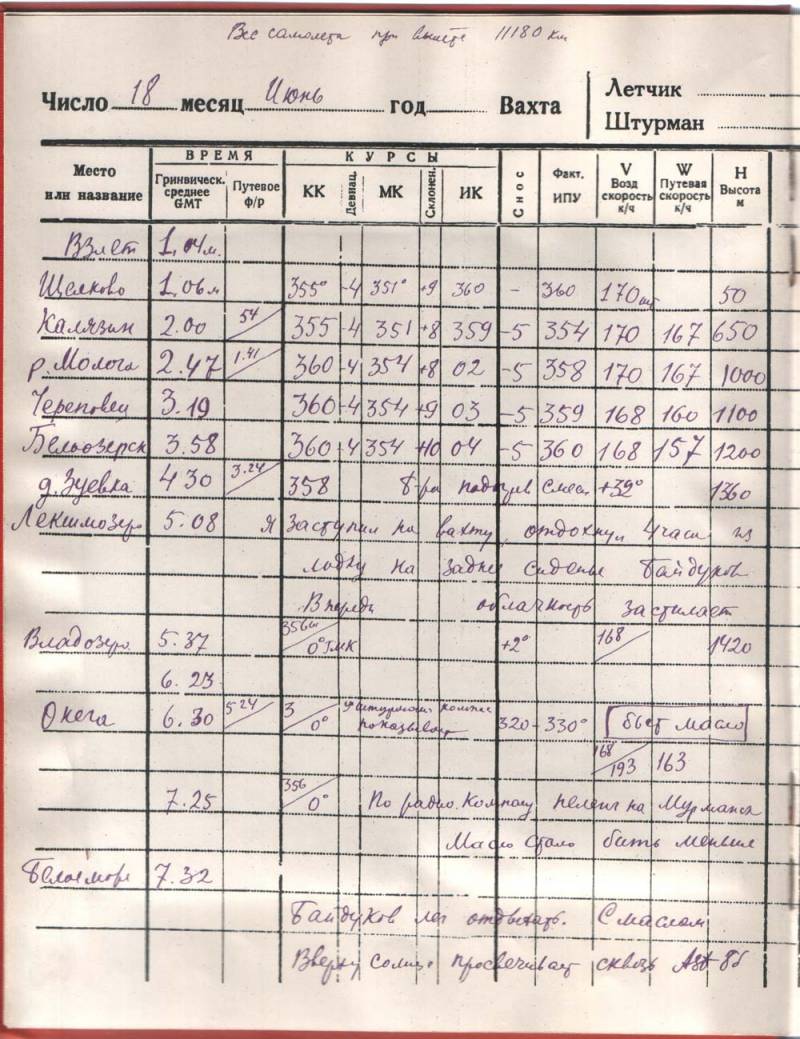
Information